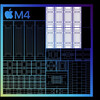Apple M4 40-core GPU vs Apple M4 16-core GPU vs Apple M4 8-core GPU
Apple M4 40-core GPU
► remove from comparisonThe Apple M4 Max GPU (40 cores) is an integrated graphics adapter that's built into the 16-core Apple M4 Max SoC. It features 40 "cores" and has access to at least 48 GB of fast 546 GB/s LPDDR5x on-package RAM depending on the configuration. As is typical for graphics adapters released in 2024, it has hardware support for ray tracing as well as mesh shading and other modern technologies. It also supports external displays with resolutions as high as "8K" and can HW-decode a few popular video codecs such as h.264, h.265 and AV1.
Performance
Its gaming performance is set to be approximately as good as that of the GeForce RTX 4070 Laptop. Please keep in mind that very few games have been compiled specifically for Apple silicon Macs meaning most titles have to be run via emulation layers. Some of them are displayed with visual artefacts as a result, or don't start at all.
Power consumption
Given the power on offer, we expect the iGPU to consume over 45 W when under heavy loads.
Just like the rest of the Apple M4 Max chip, the integrated graphics adapter is manufactured on a "second generation 3 nm" TSMC process which is still cutting-edge as of late 2024.
Apple M4 16-core GPU
► remove from comparisonApple M4 8-core GPU
► remove from comparison
Die 8-Kern-GPU Apple M4 ist eine Grafikkarte, die in den kleinsten SoC der kleinsten SoC der Apple M4-Serie die im Oktober 2024 zusammen mit dem neuen iMac. Es ist nicht klar, ob es sich um eine 10-Kern-M4-GPU mit zwei deaktivierten Kernen ist, oder ob Apple tatsächlich einen völlig neuen M4 SoC herstellt, der von vornherein weniger CPU- und GPU-Kerne hat. Einige beliebte Videocodecs können hier HW-dekodiert und HW-enkodiert werden, aber die Liste ist bei weitem nicht so lang wie die aktueller AMD iGPUs, ganz zu schweigen von Intel iGPUs. Es gibt jedoch eine gesunde Auswahl an modernen Technologien wie Raytracing im Angebot.
Genau wie der Rest des Apple M4 Chips wird die Grafikkarte in einem TSMC-Prozess der zweiten Generation (3 nm) gefertigt, der auch Ende 2024 noch auf dem neuesten Stand der Technik ist. Er hat Zugriff auf 16 oder 24 GB LPDDR5X-7500 Unified-RAM und ermöglicht neben dem internen Display des iMac den Anschluss eines weiteren Monitors mit einer "bis zu 6K"-Auflösung, während die 10-Kern-GPU 2 solche Monitore ansteuern kann.
Seine Leistung soll etwa 15% niedriger sein als die der 10-Kern-M4-GPU. Dennoch wird sie mindestens so schnell sein wie die Radeon 760M bei vielen Aufgaben.
| Apple M4 40-core GPU | Apple M4 16-core GPU | Apple M4 8-core GPU | |||||||||||||||||||||||||||||||||||||||||||||||||||||||
| Apple M4 Serie |
|
|
| ||||||||||||||||||||||||||||||||||||||||||||||||||||||
| Pipelines | 40 - unified | 16 - unified | 8 - unified | ||||||||||||||||||||||||||||||||||||||||||||||||||||||
| Raytracing Cores | 40 | ||||||||||||||||||||||||||||||||||||||||||||||||||||||||
| Speichertakt | 8533 MHz | ||||||||||||||||||||||||||||||||||||||||||||||||||||||||
| Speichertyp | LPDDR5x-8533 | LPDDR5x-8533 | LPDDR5X-7500 | ||||||||||||||||||||||||||||||||||||||||||||||||||||||
| Shared Memory | ja | ja | ja | ||||||||||||||||||||||||||||||||||||||||||||||||||||||
| Memory Bandwidth | 546 GB/s | 273 GB/s | |||||||||||||||||||||||||||||||||||||||||||||||||||||||
| Stromverbrauch | 45 Watt | 4 Watt | |||||||||||||||||||||||||||||||||||||||||||||||||||||||
| Herstellungsprozess | 3 nm | 3 nm | 3 nm | ||||||||||||||||||||||||||||||||||||||||||||||||||||||
| Notebookgröße | groß (17" z.B.) | ||||||||||||||||||||||||||||||||||||||||||||||||||||||||
| Erscheinungsdatum | 30.10.2024 | 30.10.2024 | 28.10.2024 | ||||||||||||||||||||||||||||||||||||||||||||||||||||||
| Predecessor | M3 8-Core GPU |
|
|
| ||||||||||||||||||||||||
Benchmarks
Cinebench R15 OpenGL 64 Bit + Apple M4 16-core GPU
GFXBench T-Rex HD Offscreen C24Z16 + Apple M4 16-core GPU
Average Benchmarks Apple M4 16-core GPU → 0% n=0
* Smaller numbers mean a higher performance
1 This benchmark is not used for the average calculation
Spiele-Benchmarks
Die folgenden Benchmarks basieren auf unseren Spieletests mit Testnotebooks. Die Performance dieser Grafikkarte bei den gelisteten Spielen ist abhängig von der verwendeten CPU, Speicherausstattung, Treiber und auch Betriebssystem. Dadurch müssen die untenstehenden Werte nicht repräsentativ sein. Detaillierte Informationen über das verwendete System sehen Sie nach einem Klick auf den fps-Wert.

Baldur's Gate 3
2023| Apple M4 16-core GPU | low | med. | high | ultra | QHD | 4K |
|---|---|---|---|---|---|---|
| Cyberpunk 2077 2.1 Phantom Liberty | 55.2 | 49.2 | 41.3 | 35.7 | ||
| Baldur's Gate 3 | 50.3 | 36 | ||||
| < 30 fps < 60 fps < 120 fps ≥ 120 fps | 1 | 1 | 1 | 2 | 1 | |
Eine Liste mit weiteren Spielen und allen Grafikkarten finden Sie auf unserer Seite: Welches Spiel ist mit welcher Grafikkarte spielbar?










